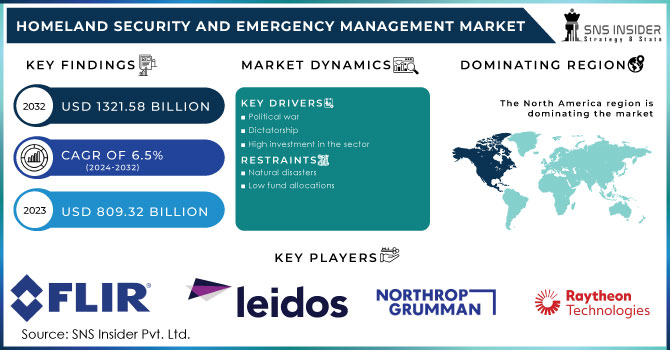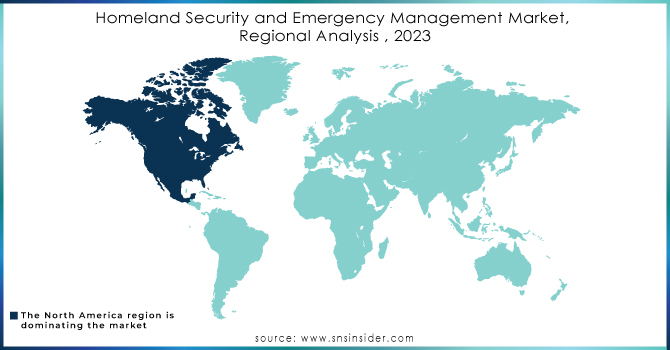Homeland Security and Emergency Management Market Report Scope & Overview:

To get more information on Homeland Security and Emergency Management Market - Request Free Sample Report
The Homeland Security and Emergency Management Market was valued at US$ 809.32 billion in 2023, expected to reach USD 1321.58 billion by 2032 and grow at a CAGR of 6.5% over the forecast period 2024-2032.
Individuals are provided with welfare and safety during calamities and disasters through homeland security and emergency management. Homeland security and emergency management assist in the prevention and management of risks, particularly those having catastrophic effects on regions, communities, or entire countries. Increased procurements of better security systems for intercepting terrorist attacks have been a growth generator for the homeland security and emergency management market, and this trend is expected to continue during the forecast period.
Increased investments in airports, seaports, and border security, as well as the development of customs and immigration services, are driving the market growth.
With increased digitalization, cyber dangers are increasing at an alarming rate. This is expected to compel governments throughout the world to tighten their cyber security in order to protect government and commercial sector IT systems.
MARKET DYNAMICS
KEY DRIVERS
-
Political war
-
Dictatorship
-
High investment in the sector
RESTRAINTS
-
Natural disasters
-
Low fund allocations
OPPORTUNITIES
-
Growing Services & Cloud-based applications
-
Enhancing cybersecurity
CHALLENGES
-
Threats recognition rate
-
Insider attacks
THE IMPACT OF COVID-19
The influence of COVID-19 has been studied under three different categories: realistic, optimistic, and pessimistic. For additional calculations, the realistic scenario was taken into account. To some extent, the manufacture of sophisticated sensors and related component lines has been impacted. However, due to the issue of multiple product development contracts between January 2020 and July 2020, there has been a steady need for surveillance and intelligence collecting systems in homeland security and disaster management. Numerous countries, notably the United States and China, have reduced their respective budget allocations for homeland security and emergency management while shifting some cash for pandemic preparedness. Furthermore, the supply chain on both the demand and supply side is experiencing significant disruption, resulting in order completion or cancellation delays.
The systems category is likely to lead the homeland security and emergency management market due to rising worldwide threats. One of the primary aspects driving the expansion of the systems segment is the increasing demand for non-lethal weapons used to suppress riots. The segment's rise is being fueled by an increase in the acquisition of new homeland security systems by various law enforcement agencies throughout the world.
This segment's rise can be ascribed to a variety of issues, including changing climatic conditions, increased natural disasters, government emphasis on safety laws, frequent terror attacks, and domestic violence. Because the bulk of existing installations have either become obsolete or are running on antiquated technologies, homeland security and emergency management agencies are looking for improved and technologically sophisticated solutions. Several Tier 1 firms are currently delivering technologically advanced and sophisticated solutions in the homeland security and emergency management industry. The segment held the biggest market share and is predicted to grow at the fastest rate during the forecast period. This is because homeland security and emergency management agencies around the world are increasing their demand for homeland security systems such as intelligence and surveillance systems, detection and monitoring systems, weapon systems, and communication systems for command, control, and improved situational awareness. Professional services and managed services are included in the service section. In 2022, the managed services sector held the greatest market share. Managed services are often ongoing and can address a wide range of an organization's security requirements.
KEY MARKET SEGMENTATION
By Application
-
Military
-
Homeland Security
-
Cyber Protection
-
Commercial
-
Emergency Management
By Component
-
System
-
Services
By Platform
-
Land
-
Maritime
-
Airborne
-
Space
By Installation Base
-
Fixed Command Centers
-
Deployable Command Centers
By Installation
-
New Installation
-
Upgrade
REGIONAL ANALYSIS
North America dominates the national security and emergency management market. The trend is expected to continue during the forecast period due to the presence of key players, such as General Dynamics Corporation, Lockheed Martin Corporation, and Raytheon Company, as well as the high investment these companies have made in the development of advanced systems and solutions. The increasing adoption of programs developed by the European Homeland Security Organization for intelligence, surveillance, and re-surveillance is expected to increase the need for national security and emergency management during the review period. The market in the region is expected to grow at a higher CAGR during the forecast period. Increased defense costs and rising terrorist acts in countries such as India, China, Indonesia and Australia, drive market growth in the region.
Rising international defense costs, such as Saudi Arabia, the UAE, and Israel, drive market growth in the Middle East and Africa.
In Latin America, there has been an increase in the use of advanced intelligence-gathering programs related to drug trafficking by rebel groups, deforestation surveillance, and illegal migration control, which is expected to boost national security market and emergency management.

Need any customization research on Homeland Security and Emergency Management Market - Enquiry Now
REGIONAL COVERAGE:
-
North America
-
USA
-
Canada
-
Mexico
-
-
Europe
-
Germany
-
UK
-
France
-
Italy
-
Spain
-
The Netherlands
-
Rest of Europe
-
-
Asia-Pacific
-
Japan
-
south Korea
-
China
-
India
-
Australia
-
Rest of Asia-Pacific
-
-
The Middle East & Africa
-
Israel
-
UAE
-
South Africa
-
Rest of Middle East & Africa
-
-
Latin America
-
Brazil
-
Argentina
-
Rest of Latin America
-
KEY PLAYERS
The Major Players are Raytheon Company, Northrop Grumman, Leidos, IBM, FLIR Systems, Thales Group, General Dynamics, Unisys, Elbit Systems Ltd. and Others Players
| Report Attributes | Details |
|---|---|
| Market Size in 2023 | US$ 809.32 Billion |
| Market Size by 2032 | US$ 1321.58 Billion |
| CAGR | CAGR of 6.5% From 2024 to 2032 |
| Base Year | 2023 |
| Forecast Period | 2024-2032 |
| Historical Data | 2020-2022 |
| Report Scope & Coverage | Market Size, Segments Analysis, Competitive Landscape, Regional Analysis, DROC & SWOT Analysis, Forecast Outlook |
| Key Segments | • By Application (Military, Homeland Security & Cyber Protection and Commercial, Emergency Management) • By Component (System and Services), Platform (Land, Maritime, Airborne and Space) • By Installation Base (Fixed Command Centers and Deployable Command Centers) • By Installation (New Installation, Upgrade) |
| Regional Analysis/Coverage | North America (USA, Canada, Mexico), Europe (Germany, UK, France, Italy, Spain, Netherlands, Rest of Europe), Asia-Pacific (Japan, South Korea, China, India, Australia, Rest of Asia-Pacific), The Middle East & Africa (Israel, UAE, South Africa, Rest of Middle East & Africa), Latin America (Brazil, Argentina, Rest of Latin America) |
| Company Profiles | Raytheon Company, Northrop Grumman, Leidos, IBM, FLIR Systems, Thales Group, General Dynamics, Unisys, Elbit Systems Ltd., Others |
| DRIVERS | • Political war • Dictatorship • High investment in the sector |
| RESTRAINTS | • Natural disasters • Low fund allocations |

